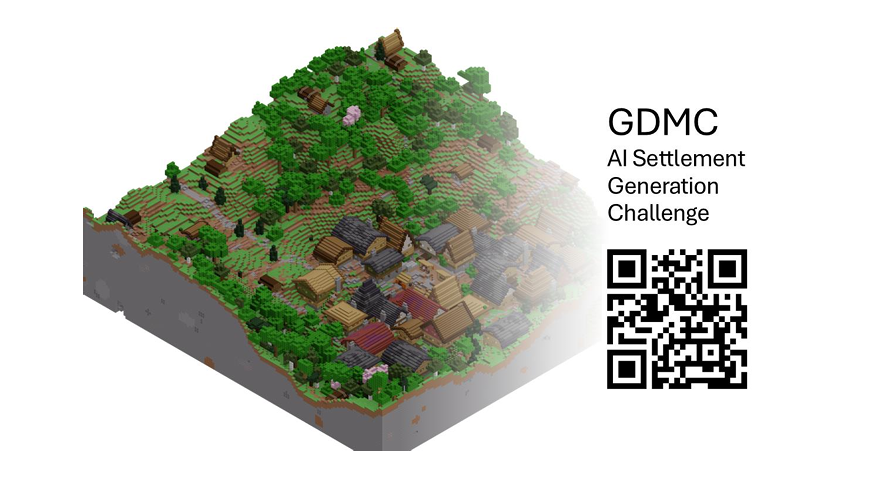
Introduction
The GDMC competition is about writing an algorithm that can produce an “interesting” settlement for a previously unseen Minecraft map. It was designed to provide an AI competition focussed on computational creativity, co-creativity and adaptive, as well as holistic PCG. There are about 25 introductory, framework-tutorial, showcase and media coverage videos about GDMC at this point. Here is a small selection:
We have an active and helpful community, with over 500 discord members, and GDMC being used in classes in at least 8 universities internationally. We have also been covered in traditional media, such as MIT Tech review1, several online videos and podcasts (see videos), and have been invited to the Microsoft Research Summit on Game AI. Several papers2 have been published both about the competition, and by our participants about their entries. The are numerous master and bachelor theses written in this framework now.
The Settlement Generation Challenge is about writing an algorithm that can create a settlement for a given, unknown Minecraft map. The challenge is to produce an algorithm that is adaptive towards the provided map, creates a settlement that satisfies a range of functional requirements – but also looks good and evokes an interesting narrative. The goal is to basically produce an algorithm that can rival the state of the art of what humans can produce.
Logistics
Competitors have to write code that can algorithmically produce a Minecraft Settlement. We support two frameworks, but allow others upon request. Once framework is the Amulet Editor, a successor of MCEdit, a common Minecraft map editor, that allows for the use of scripts – and participants would write such a script. The other option is an http framework, developed by our community members, that allows interaction with a Minecraft map a runtime. Clients that interact with this http interface can be written in any language and there are xample implementations to get started in C#, Python and Java, with written and video tutorials vailable. Furthermore, when starting out we have a discord community that shares approaches and techniques to both help people to get started and to share and celebrate their ideas. The ommunity sees this more as a festival of ideas than a competition and even the participants who build something and then not submit in the end often find the experience rewarding.
Competitors submit their algorithm, in one of the two formats, by providing us with a GitHub or download link via a submission form. We then send the participants the competition maps and have them apply their algorithms, and return the maps. The resulting maps and settlements are then ent out to a panel of expert and public judges, who score each algorithm in four categories: adaptivity,functionality, evocative narrative and aesthetics3. Our wiki contains information on how all the awards are given out.
We plan to award the following categories:
Best Settlement (for which we hope to apply to the IEEE CIS prize fund again)
Best Chronicle (award, but no prize)
Technical Innovation Award (optionally awarded by the organizers and technical committee, via internal vote, to honor amazing technical or academic progress, even if it did not result in a good score.)
The second track, chronicle, is about making a text that has a good “fit” with the generated settlement. And while we have been running this award for a few years now, we imagine that rapid development of LLMs might produce some interesting results this year, particularly in regards to he open question of aligning textual generation with information about the game world.
Participants
This is the 8th iteration for the competition. We had 11, 12, 21, 11, 7, 4 and 5 team submissions in previous years. Past participants have been university student, school children, researcher and hobbyists from around the world. We switched to two new frameworks two years ago, one being developed by our active community and the other one being a more modern map editor for Minecraft. We hope that with familiarity with the framework our numbers will rise this year. Our wiki contains information about all past years, including links to their code, results, generated settlements, write ups, etc.
Timeline
February 2025: Official Competition Announcement and rules publication
15th of June, 2025: Submission Deadline, subsequent Generation of Settlements
30th of June, 2025: Start of Evaluation Period
15th of August, 2025: Deadline for Judge Evaluation
End of August, Results Announced, both at IEEE Cog and online
Organizers
Christoph Salge, University of Hertfordshire, UK, ChristophSalge@gmail.com
Michael Cerny Green, NYU, US
Rodrigo Canaan, Cal Poly State University, US
Christian Guckelsberger, Aalto University, Finland & QMUL, UK
Victoire Hervé, University of Hertfordshire, UK
Niels Poldervaart, Leiden University, Netherlands
Julian Togelius, NYU, UK
The organizers have run this competition for 7 years now, and organizes a few other competitions, served as competition chairs to various conferences, etc.
External links
Twitter & BlueSky: @gendesignMC
